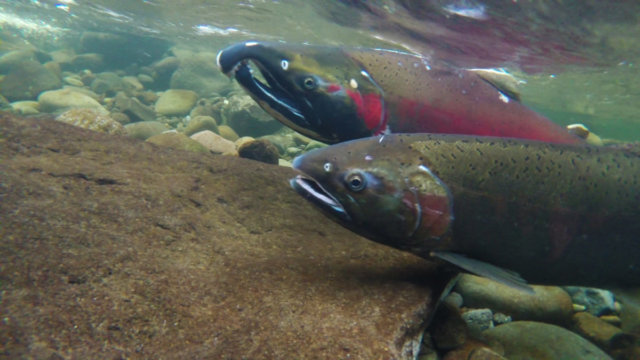

By Susie Neilson
Reveal from The Center for Investigative Reporting
BORING, Oregon – Right under the highway and wedged between a plant nursery and an auto manufacturer, a toxic trickle flows. This tributary of the Clackamas River is hardly an inviting sight. Once clear and gurgling, its muddy water barely moves, and plastic bags bunch along its shoreline.
Suzi Cloutier clambers toward the water’s edge, dipping a bottle into the creek. She pulls it out, murky and dripping, taking care to keep her hands away from the rim.

“It’s for the sample’s protection, not mine,” she half-jokes over the roar of 18-wheelers and minivans.
Cloutier routinely tests waters in the Clackamas River Basin, home to threatened and endangered species of Chinook and Coho salmon. Last year, every one of her samples from this tributary tested positive for multiple pesticides.
Salmon in this river – and throughout much of the Pacific Northwest – have dwindled from an onslaught of threats, including dams and overfishing. Scientists say pesticides from nearby farms are pushing them closer to extinction.
“It’s like kicking them when they’re down,” Cloutier says.

Under the Obama administration, the government began reviewing the impacts of all pesticides on the nation’s approximately 2,300 endangered and threatened species. Two days before President Donald Trump took office, federal officials issued a preliminary report on three highly toxic and popular agricultural insecticides, concluding that they threaten the survival of nearly 1,800 species protected by the Endangered Species Act, including 18 types of salmon.“It’s like kicking them when they’re down,” Cloutier says.
Now, under the Trump administration, these reviews have ground to a halt.
Reveal from The Center for Investigative Reporting has uncovered a close relationship between pesticide companies and federal agencies, mirroring a pattern the Trump administration has followed with many other regulated industries. The pesticide industry has spent years trying to fend off regulations designed to protect endangered species. Under Trump, it is succeeding.
Among the findings, according to documents obtained and interviews conducted by Reveal:
- Three federal environmental agencies are reshaping the scientific methods used in their reviews at the request of pesticide manufacturers. Some researchers and advocates say that if these reviews, known as biological opinions, do begin again, this change could shift the results in favor of the pesticide industry – and away from protecting endangered wildlife.
- Officials from all three agencies held a meeting with key pesticide manufacturers, teaching them how to influence the reviews of their products. Manufacturers, in turn, schooled the government on what data to use.
- The agencies have granted repeated delays in the reviews to resolve questions posed by the companies that scientists say already have been addressed. One agency, the National Marine Fisheries Service, has rebuked its own 3,749-page report, which had documented that pesticides threaten half of the fish and other endangered species under its jurisdiction.
- A major pesticide manufacturer, Dow AgroSciences, has poured money into lobbying federal agencies and Congress to influence the endangered species review process. Its parent company, Dow Chemical Co., also donated to Trump’s inauguration, and several of its former higher-ups now hold prominent positions in agencies that regulate pesticides.
The delays in the pesticide reviews are worrisome to scientists who research contaminants’ effects on wildlife.
John Stark, a Washington State University ecotoxicology professor who studies salmon, called the delays “really unfortunate. These pesticides are damaging wild (salmon) populations. And they’re still used and used extensively.”
Stark, who contributed to the federal fisheries review, said there is no scientific reason to delay the reviews to conduct more research.
“The review is one of the most comprehensive, well-done and thorough studies I’ve seen done in my life,” he said.
CropLife America, the trade association representing pesticide manufacturers that has advocated for the delays, said in a statement to Reveal that the reviews had relied on “overly conservative assumptions and superficial analysis.”
The goal of the companies is to help the federal agencies “develop an efficient, science-based approach” that will ensure species and their habitat “are protected while recognizing the essential role that pesticides play in the US food system, as well as the protection of public and private lands, homes and human health,” the statement says.
New way to review pesticides
In the 45 years since Congress enacted the Endangered Species Act, wildlife hasn’t had much protection from pesticides. So in 2011, after environmental advocates sued multiple times, the Environmental Protection Agency asked the independent National Academy of Sciences to invent a new way of assessing the risks to endangered species.
Two years later, the process the academy came up with was rather complex: It required three agencies – the EPA, U.S. Fish and Wildlife Service and National Marine Fisheries Service – to report on the risks of every pesticide. To pilot this approach, the agencies started with malathion, chlorpyrifos and diazinon. Known as organophosphates, they are derived from chemicals developed in Nazi Germany as nerve gases.
Malathion, chlorpyrifos and diazinon target nervous systems, making them highly effective insecticides. They’re used to control pests on crops, vegetable gardens and Christmas tree farms. Although organophosphate use has declined since Cloutier’s childhood in the early 1980s, when she says helicopters regularly sprayed her hometown of Oakland, California, with malathion to kill crop-damaging Mediterranean fruit flies, the chemicals are still popular. According to the U.S. Geological Survey, an estimated 5.8 million pounds of chlorpyrifos, 200,000 pounds of diazinon and 900,000 pounds of malathion were used nationwide in 2015.
And they don’t harm just their targets. These chemicals alter salmon’s swimming patterns, reproductive systems and pursuit of prey, according to Nat Scholz, a scientist at the National Marine Fisheries Service who’s been studying organophosphates and salmon for decades. A salmon uses its powerful sense of smell – thousands of times better than a dog’s – in almost every vital endeavor, from finding food to avoiding predators and migrating. Even low exposure to organophosphates can permanently impair this sense.
In one study, Scholz and other scientists found that any mix of malathion, diazinon and chlorpyrifos at concentrations as low as several parts per billion – including the levels of diazinon and chlorpyrifos found along the Clackamas – can harm or kill Coho salmon.
“Studies on the toxicity of these chemicals to salmon and other fish date back decades,” Scholz said. “By design, organophosphates interfere with the normal function of the nervous system.”
Humans face risks from organophosphates, too. Researchers have linked chlorpyrifos, malathion and diazinon to reduced IQs in California children exposed in the womb. Last year, chlorpyrifos gained national notoriety when former EPA Administrator Scott Pruitt rejected a long-awaited ban on agricultural uses of the chemical.
Under President Barack Obama, the agencies working on pesticide reviews ensured the process was open to the public. They held five open workshops on their scientific methodologies, and the public was allowed to comment on drafts of their evaluations for 10 weeks in 2016. The EPA responded to 78,000 public comments, as well as industry critiques, in detail. On the second-to-last day of the Obama administration, the EPA published its initial reviews of the three pesticides, showing widespread harm to 1,778 species.
The agencies also agreed to a court-imposed deadline: By the end of 2017, the Fish and Wildlife Service and National Marine Fisheries Service would publish final biological opinions on the three pesticides.
Once Trump took office, “public input was halted on everything,” said Nathan Donley, a senior scientist at the Center for Biological Diversity, an advocacy group that is suing the EPA for its failure to provide the reviews.
“The strategy here is to delay, delay, delay,” he said. “Meanwhile, there are species with a few hundred individuals left. And they’re getting poisoned right now.”
Shifting science or delay tactic?
In April 2017, 10 federal agencies and committees received a letter from David B. Weinberg, legal adviser to the three largest manufacturers of organophosphates – Dow AgroSciences LLC; Makhteshim Agan, now known as Adama; and FMC Corp.
Weinberg wrote that the federal approaches to the science were “fundamentally flawed and should be set aside.” The companies said the agencies did not adequately consider how products actually were applied, but instead considered their effects at maximum use.
The reviews, in other words, need to be “science and reality based,” CropLife America said in its statement.
There’s a problem with this argument, however: “Actual use” data is limited. California and Arizona are the only states that require pesticide applicators to report their use, according to the Western Integrated Pest Management Center. Also, such data is not predictive. In other words, even if a pesticide isn’t used one year, it could be used later, especially for rotating crops such as soybeans.
Following Weinberg’s requests, the Fish and Wildlife Service in November sent a letter to the EPA requesting additional time to complete its final assessment. The wildlife agency sought data that mirrored the concerns of industry, especially actual use data and “extrapolation to areas where actual use data does not exist or cannot be obtained.”
Three days later, the EPA replied, granting the Fish and Wildlife Service’s request: “We agree that consultation should continue and be extended as necessary.”
The agencies did not specify when or if they would complete their reviews.
An EPA spokesman said the agency was working with the Fish and Wildlife Service to gather additional information on how and where the pesticides are used. Officials from both agencies said they did not have an estimated completion date for the biological opinions. The marine fisheries service declined to comment, citing ongoing litigation.
Since 2016, Dow AgroSciences has spent about $800,000 lobbying the EPA and Congress against organophosphate regulations, according to disclosures. Also, four months before it asked to delay the reviews, parent company Dow Chemical donated $1 million toward Trump’s inauguration. Dow Chemical CEO Andrew Liveris recently had been chosen by Trump to lead the American Manufacturing Council, which disbanded in August.
Several more of Dow’s former higher-ups also have been appointed to positions in pesticide-regulating federal agencies. Former executives Ken Isley and Ted McKinney now work in top positions at the U.S. Department of Agriculture. In March, Trump nominated Peter C. Wright, a longtime corporate lawyer at Dow, to serve as an EPA assistant administrator. Trump’s pick to lead the EPA’s Office of Chemical Safety and Pollution Prevention, Michael Dourson, was paid by Dow AgroSciences to produce research papers casting doubt on the toxic effects of chlorpyrifos. (Following public outcry, Dourson withdrew himself from consideration in December.)
Dow AgroSciences did not respond to repeated requests for comment.
On the surface, many of the manufacturers’ requests sound reasonable. After all, they are asking for more on-the-ground data and corrections to flaws in the current assessment. But environmental advocates and scientists say the requests are scientifically unwarranted.
“What they’re doing is stall more. It’s ridiculous,” said attorney Patti Goldman of the environmental law organization Earthjustice, which has been suing agencies over organophosphates since the 1990s. “The finding (that organophosphates are harmful) is not going to change.”
Stark, the Washington State University professor, calls the documented effect of organophosphates and other pesticides on salmon “pretty incredible.” He said the National Marine Fisheries Service review was so thorough that it used population modeling, a complex tool that measures pesticides’ impact on individual species – something that no federal environmental risk assessment had included before. The report also traced the journeys of pesticides from spray to breakdown and developed toxicology reports.
Kevin Masterson, a researcher at the Oregon Department of Environmental Quality who has been collecting and analyzing Cloutier’s data, agreed that organophosphates’ potential for harming wildlife already is well established.
“For those chemicals, the standards have been around for so long,” he said. “We know if it’s showing up at subparts per billion that it could be having an effect, either a chronic or acute effect, on aquatic life.”
Icon of the Pacific Northwest
At the turn of the 20th century, the Clackamas overflowed with salmon, providing ample food and wealth to the region. Some years, the catch was so large that fishermen dumped scores of surplus carcasses back into the river. The writer Rudyard Kipling visited the Clackamas then and wrote about its mighty hauls: “Salmon by the hundred – huge fifty-pounders, hardly dead, scores of twenty and thirty-pounders … burst(ing) out in a stream of quick-silver.”

Since then, the river has been overfished, dammed and polluted. The salmon have suffered: Since 1970, fall-run Chinook have dwindled from more than 34,000 fish to less than 4,000. A government report in 2008 found 63 types of pesticides in salmon spawning sites along the Clackamas.
“Given their frequent and widespread occurrence, especially during storms, pesticides have the potential to affect aquatic life and the quality of drinking water derived from the lower river,” the report concluded.
Two of these pesticides, chlorpyrifos and diazinon, regularly show up in concentrations greater than a threshold deemed safe for aquatic life by the Oregon Department of Environmental Quality. The largest concentrations occur in small tributaries, where salmon like to spawn and raise their babies, putting younger fish at risk of exposure.
The Clackamas runs alongside berry farms, plant nurseries and Christmas tree groves, making it a pooling point for organophosphate runoff. According to one government study, 99 percent of malathion, 86 percent of chlorpyrifos and 16 percent of diazinon sprayed on crops ran off fields into nearby waterways within 15 days of application.
Once in the water, pesticides mingle, compounding their effects on aquatic life, according to studies by Scholz, the National Marine Fisheries Service scientist. And the Clackamas is a tributary of the Willamette River, also home to several endangered species of salmon, which receives still more organophosphates from pesticides sprayed on vineyards and other farms in the nearby Willamette Valley.
Documenting delays
Of the two agencies tasked with delivering a final biological opinion by the end of 2017, only the National Marine Fisheries Service published its review by the deadline imposed by a court order.
The document, supported by more than 900 cited studies, reviews and reports, found that of the 77 species for which the fisheries service had jurisdiction, the three organophosphates together likely would harm 49 percent of the listed species, including several varieties of sea turtles, sea lions, killer whales and 18 species of salmon. The species most at risk, the report said, are those that inhabit shallow waters near farms and other pesticide use sites.
The agency’s publishing announcement derided the quality of its own work, suggesting it was rushed and therefore invalid, despite years of prior discussions, analyses and decisions.
“Unfortunately, (the fisheries service) … was required to transmit the biological opinion which, given the time, cannot fully account for the need to coordinate on a different process for developing such opinions or to fully engage the public,” officials wrote in their announcement.
In January, less than a month after it originally was supposed to publish a biological opinion, the EPA created a working group to re-evaluate the pesticide reviews. The group will “help provide clarity as to what constitutes the ‘best scientific and commercial data available’ in the fields of pesticide use and ecological risk assessment” and “is not prohibited from seeking or receiving stakeholder expertise, experience, input, information, or other items deemed appropriate.”
In February, Richard Keigwin, director of EPA’s Office of Pesticide Programs, sent a letter to the fisheries service, saying its report had a “general lack of transparency and reproducibility,” its estimates were too conservative and its suggestions impractical.
One month later, on March 23, the EPA reopened the biological opinion for comment. A month after that, the EPA and Fish and Wildlife Service held a meeting for representatives of the manufacturers of the organophosphates being examined. Participants included government scientists and representatives from FMC, Dow and Adama.. No environmental groups were invited.
According to a record of the meeting, government scientists briefed applicants on how to comment on draft reports and updated them on the status of the pesticide consultation – an update the public and environmental advocates have yet to hear.
The pesticide executives, in turn, provided government officials with a handout suggesting ways to measure the organophosphates, obtain use information and refine data on how endangered species are exposed. They proposed three more meetings between government and industry. The document does not specify who called the meeting, how long the additional data would take to gather or whether the proposed meetings would take place.

(Oregon State University / Flickr)
Stephanie Parent, a senior attorney at the Center for Biological Diversity, said this sort of meeting between industry and federal scientists is “probably not unusual.” But she said under the Trump administration, these meetings are likely happening more and having more influence.
Several days after the meeting, five pesticide businesses, coalitions and associations – including Adama and FMC – posted requests to extend the National Marine Fisheries Service review’s comment period 90 days, until Aug. 20. The EPA partially granted the request, extending it to July 23.
With these repeated delays, it’s unknown if or when federal officials will implement measures to protect the nation’s endangered species from pesticides.
After collecting samples at the polluted creek in Oregon, Cloutier and fellow conservationist Sharon Selvaggio drive to a nearby protected forest. The Clackamas here thunders along, cold and healthy: Cloutier detects pesticides here at a fraction of what she finds at the first site and sees far more salmon.
“You’d never believe it, but this is how (the first site) used to look,” Selvaggio says.
With the right protections in place, they say, perhaps it could be this way once again.
(Editor’s note: This story was produced by Reveal from The Center for Investigative Reporting, a nonprofit news organization. NonDoc has published it here in accordance with their republishing terms. Learn more at revealnews.org and subscribe to the Reveal podcast, produced with PRX, at revealnews.org/podcast.)




















